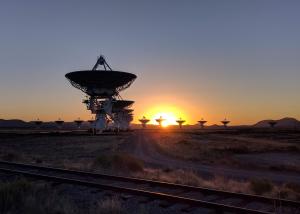Journal
Steel Magnolias
11 May 2019
 NRAO/AUI/NSF
NRAO/AUI/NSFYou first see them on the edge of the horizon. As you drive into the wide plain of an ancient lava bed, they look like specks of white against the backdrop of rising blue mountains. Pockets of snow, or reflections of the grey clouds overhead. Their presence reveals nothing of their purpose. Little more than standing stones marking a desolate land.
The desert plain is ancient. Smoothed by volcanic flow bellowed by the rising of the rocky mountains to the east. After the lava cooled, melted snow washed over it to form a great inland sea. When the first humans arrived from Asia, the shores of this sea became home for a time. But then the sea dried, and the tribes of humans moved on. There was better hunting to the south, at lower elevations. Sediment covered the lava plain, and again the land was alone.
But humans are persistent and curious, so the land wasn’t alone for long. High and dry plains are perfect for those who long for the stars, so soon astronomers came. And as our car entered the plain, the mark of these astronomers showed as pale white on the horizon. As we approached the observatory, the small white dots grew and took form. A scattering of white dishes, working together to see the sky. Like steel flowers striving to capture the Sun.
The VLA uses 27 dishes to create a single view of the sky. Each dish captures a stream of radio light, and together they create a single detailed view. It is the curiosity and tenacity of humans that drives us to create these observatories. These steel flowers of the desert clearly show that humanity walks upon the Earth. But their design is also driven by physics.
The dishes are curved into the shape of a flower so that the faint signals from space can focus onto the detectors. They are painted white so that the sunlight that strikes them isn’t focused to warm the dish too much. They are mounted to be able to steer and turn to see the full sky. Physics requires this, not humans. There are many ways humans imprint their heritage on the world, from art to music, but the design of these dishes have a universal quality.
It is interesting to think that across the vast cosmos there could be other curious creatures. Creatures who also look to the sky in wonder. If they do, the radio observatories they use would look similar to ours. On an alien plain there could also be steel magnolias, watching the sky with the same cosmic wonder.